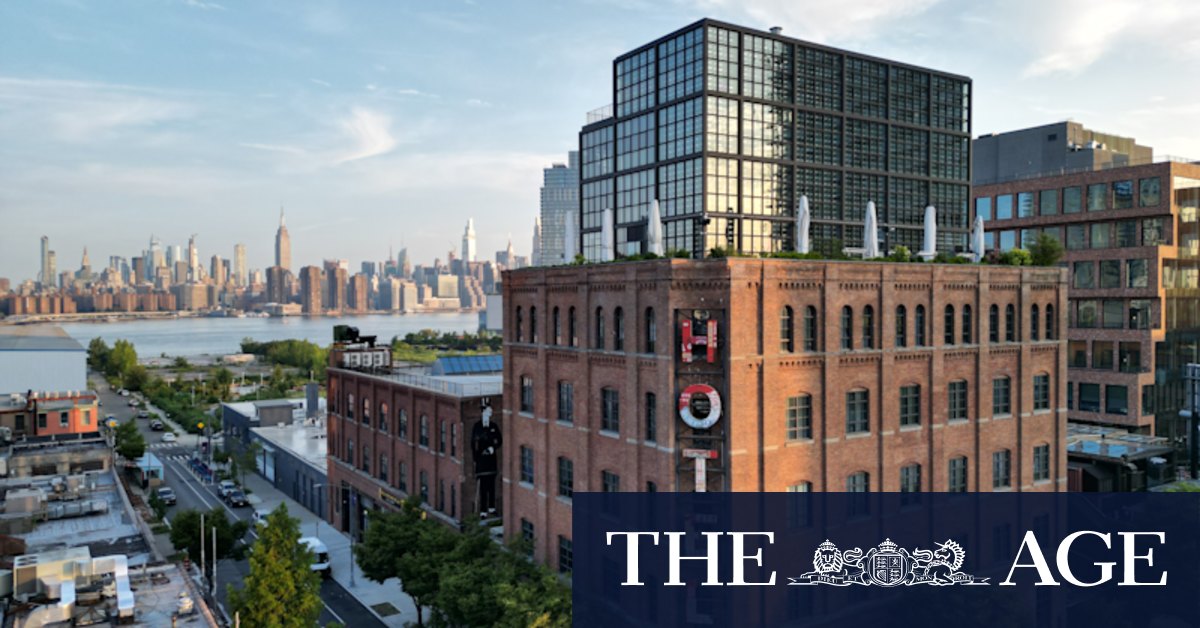
October 25, 2025 — 5:00am
Save
You have reached your maximum number of saved items.
Remove items from your saved list to add more.
Save this article for later
Add articles to your saved list and come back to them anytime.
Got itThis article is part of Traveller’s Destination Guide to New York. See all stories.
When I first started visiting Williamsburg about 25 years ago, it was nothing like it is today. It was a short subway ride from Manhattan but felt like an entirely different city.
The musicians, writers and artists were already moving across in droves, squeezed out of the East Village or Lower East Side by rising rents and gentrification, and although cool bars, cafes and stores were sprouting around the neighbourhood, it still felt like a wild outpost compared to Manhattan. Even the geography and architecture were a total contrast – low-slung three-storey apartment buildings, stretches of empty lots, a waterfront lined with abandoned warehouses, and strong migrant communities from Poland, Ukraine, Puerto Rico and the Dominican Republic.
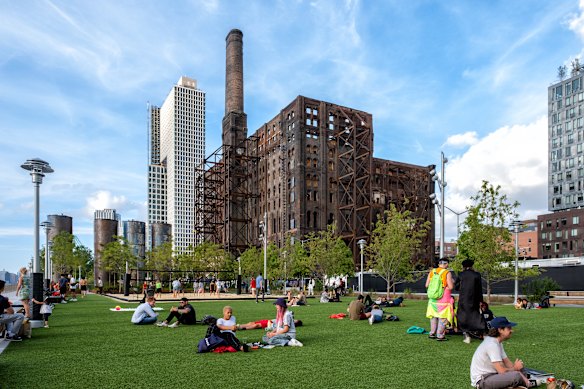 Domino Park in Williamsburg.Getty Images
Domino Park in Williamsburg.Getty Images
Each year on my trips to New York I’d head over and marvel at how quickly it hipsterised, then gentrified, then hyper-gentrified. Today, Williamsburg is New York on steroids, the epicentre of everything hot in the city.
So this year I decided to stay there for a few days to see what has changed and what has remained from the old days – and with such rapid change, the old days I’m referring to are the ’90s to mid-2000s.
Perhaps no two places represent Williamsburg’s transformation better than Diner (dinernyc.com) and the Wythe Hotel (wythehotel.com) – and both evolved from one man. Back in the early ’90s, Andrew Tarlow was a struggling artist who worked in Tribeca restaurant The Odeon. He moved across the river to Williamsburg after not being able to afford Manhattan any more, tempted by a rent of $500 for a huge loft. At the end of 1998 he opened a restaurant called Diner in a converted 1920s railway dining car on the southern side of Williamsburg.
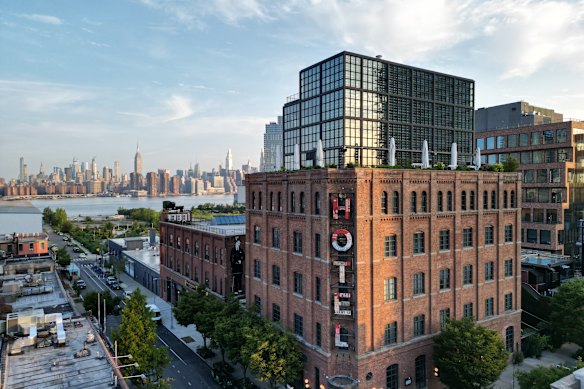 The Wythe Hotel.
The Wythe Hotel.
“It was desolate down there,” he told me when I met him a decade ago. “That’s the only word I can think of to describe it. No cars. No people. Empty lots. There was just nothing.”
As they say in Field Of Dreams, build it and they will come. Diner became a hotspot, its ethical/local take on modern American cooking – and the fact that it felt like a well-kept secret in an unheralded part of New York – made it a sensation, and it’s now an institution.
The success of Diner not only encouraged other restaurants to open in Williamsburg, it helped kickstart the whole Brooklyn artisanal food movement, aided and abetted by open-air food bazaar Smorgasburg (smorgasburg.com), which debuted in 2011. Every Saturday at Marsha P Johnson State Park, on the Williamsburg waterfront, 70 or so local stallholders sell everything from empanadas, bao buns and brisket to cupcakes, donuts and icy poles. Each year new stalls debut, many of them immigrant-owned and representing international cuisines – on this visit I sample Portuguese, French and Ethiopian delicacies.
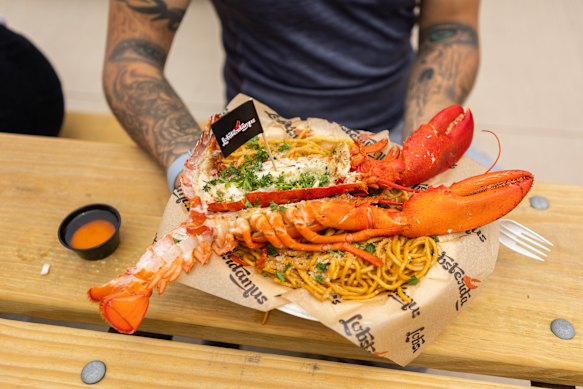 Eating big at Smorgasburg.
Eating big at Smorgasburg.
Tarlow’s next move was bigger and bolder. He and his business partners bought an old factory and built the 72-room Wythe Hotel, which opened in 2012 and was an immediate hit, clearing the path for other hotels that started mushrooming around Williamsburg – one of the latest is Moxy Brooklyn Williamsburg, the fifth New York hotel for the hip brand but the first that’s not in Manhattan.
As I walk around the neighbourhood today, I see places that have survived. The mini-mall on main drag Bedford Avenue is still fronted by Spoonbill & Sugartown Books (spoonbillbooks.com), a much-loved bookstore that has been there since 1999 and has a great art, film, music and pop culture section, along with fiction, non-fiction and magazines.
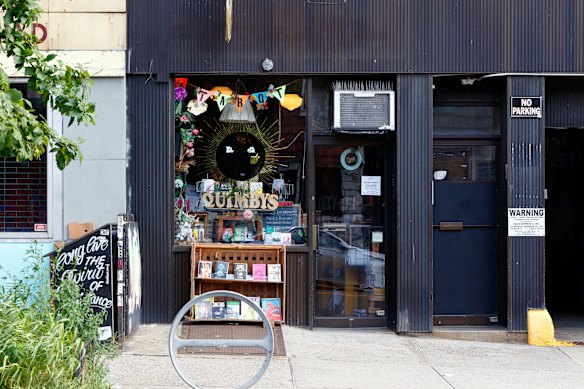 Kindred spirit … Quimby’s Bookstore, a fixture since the early ’90s.Alamy Stock Photo
Kindred spirit … Quimby’s Bookstore, a fixture since the early ’90s.Alamy Stock Photo
A little further east, on Metropolitan Avenue, is The City Reliquary (cityreliquary.org), an eccentric museum that has been there since 2006, featuring a clutter of objects that offer a window into New York history via collections of subway tokens through the years, Statue of Liberty postcards and New York World’s Fair memorabilia. Nearby is a kindred spirit – Quimby’s Bookstore (quimbysnyc.com), which specialises in ’zines, cult books and alternative press.
I spent some long, sweaty nights back in the mid-2000s at Williamsburg rock club Union Pool (union-pool.com) – it’s still there underneath the Brooklyn-Queens Expressway, catering to a new generation of 20 and 30-somethings. And the Music Hall of Williamsburg (musichallofwilliamsburg.com), which opened in 2007, still plays host to alternative music. While I was in town, Sydney indie band Middle Kids were playing there.
In the early 1900s, beer was this area’s lifeblood. At its height there were 48 breweries in Brooklyn, but Prohibition brought that number down to nine. And in 1976, with mass-market beers squeezing out the smaller operators, the last brewery in Brooklyn closed.
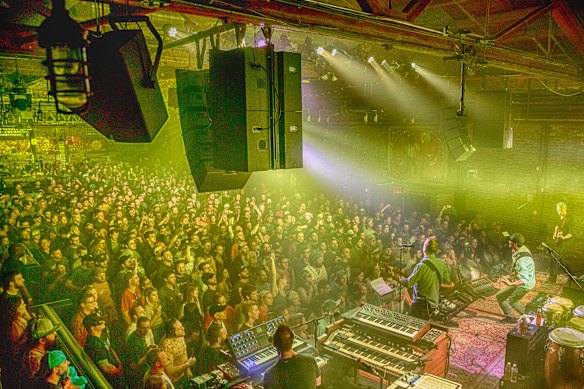 Brooklyn Bowl.
Brooklyn Bowl.
Twenty years later, in 1996, Brooklyn Brewery (brooklynbrewery.com) opened in Williamsburg. I take a public tour of the place before getting stuck into their product, and the guide tells us the Brooklyn beer industry’s saviours were an unlikely duo. Steve Hindy worked in the Middle East as a foreign correspondent. When he returned to live in Brooklyn after 15 years overseas, he pursued his love of home brewing and invited neighbours to sample his wares. One of those neighbours, a banker named Tom Potter, was so impressed he suggested they go into business together.
“May Brooklyn never again be without a brewery,” Hindy declared at the grand opening. So far his promise has borne fruit, and then some. There’s now a long list of Brooklyn breweries that just keeps growing.
Combining food and booze with other activities is a very Williamsburg thing to do. At Nitehawk Cinema (nitehawkcinema.com) I drink a cocktail and pick at a cheese plate while watching an arthouse movie; at Brooklyn Bowl (brooklynbowl.com) I indulge in three hipster activities under one roof – drinking craft beer, bowling and watching a band.
Brunch and coffee are now competitive sports here. You’ll jostle for tables on a weekend at the likes of popular brunch spots Juliette (juliettebk.com), Egg Shop (eggshopnyc.com), or Sunday In Brooklyn (sundayinbrooklyn.com), where the crunchy-on-the-outside, fluffy-on-the-inside pancakes drizzled with honeycomb praline syrup have become Instagram darlings, and taste even better than they look.
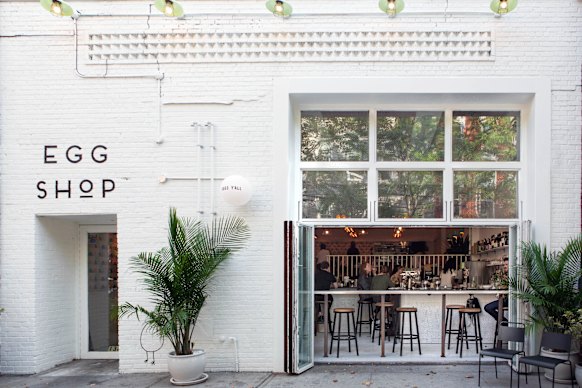 Brunch is a competitive sport … Egg Shop.
Brunch is a competitive sport … Egg Shop.
And there are great coffee shops on almost every block. Two of the best I find, for both the coffee and the experience, are Partners (partnerscoffee.com), housed in a high-ceilinged storefront with a wall of interesting tchotchkes, and Devocion (devocion.com), a sun-filled, glass-canopied space that serves Colombian brew that takes just 10 days from shipping the beans to making your cup, as opposed to 180 days in most places.
I recall wandering the Williamsburg waterfront a couple of decades ago, and as I passed abandoned warehouses and vacant lots, it felt eerie, windswept and a bit dangerous, like I was an urban adventurer.
I decide to walk that same stretch of the waterfront today, down by the old Domino Sugar Refinery, which closed in 2004. Now there’s a verdant strip called Domino Park (dominopark.com), a public recreation area and walkway that opened in 2018, designed by the same people who created the High Line in Manhattan. The sun is out and it’s teeming with people. There’s a fountain, dog park, volleyball courts, bocce court, children’s playground and outdoor taco joint.
 Domino Park incorporating the one-time sugar factory.Getty Images
Domino Park incorporating the one-time sugar factory.Getty Images
Good luck finding an abandoned warehouse or vacant lot. Back in 2005, mayor Michael Bloomberg changed the zoning of the waterfront, allowing massive condominium towers to be built. The sugar refinery is being developed as Refinery At Domino, with 6000 apartments and more than 55,000 square metres of office space, and is due to open in 2027. It joins about 500 new towers that have sprung up in less than 20 years, while luxury brands such as Hermes and Chanel have opened stores here.
The new Williamsburg divides people. Celebrated by many as a triumph of gentrification, it’s also criticised by those who mourn the loss of a neighbourhood that used to be an affordable haven for the alternative scene. If Andrew Tarlow was a young struggling artist today, he could no longer afford to live in Williamsburg. Maybe he’d try Ridgewood in Queens, which is touted as the next liveable, cool ’hood.
But that’s New York. As a waiter at Sunday In Brooklyn said to me after bringing that Instagram-ready pancake to my table, “I had someone in here yesterday who was last in Williamsburg as recently as 2019 and he said ‘What the hell happened? I hardly recognise the place’. That’s how quickly things change here.”
 Ecclectic decor at Partners Coffee.
Ecclectic decor at Partners Coffee.
But, then again, Steven Svymberksy, owner of Quimby’s Bookstore, told me: “Williamsburg is still hip despite all the gentrification. There are still used clothing shops and old Mexican restaurants and dive bars and cool stores. You just have to look for them.”
The details
Fly
Delta Air Lines flies Sydney to LAX, with 11 daily connections to New York’s JFK. See delta.com
Visit
To reach Williamsburg from Manhattan, catch a Brooklyn-bound L train, which runs along 14th Street. Get off at Bedford Avenue, the first stop across the East River, and you’re in the heart of Williamsburg.
Stay
Moxy Brooklyn Williamsburg, which opened in 2023, is right by the Williamsburg Bridge, on the main drag of Bedford Avenue. From $US179 ($289). See moxywilliamsburg.com
More
nyctourism.com
The writer was a guest of Moxy Brooklyn Williamsburg.
Sign up for the Traveller Deals newsletter
Get exclusive travel deals delivered straight to your inbox. Sign up now.
Save
You have reached your maximum number of saved items.
Remove items from your saved list to add more.
![]() Barry Divola is a journalist and author who specialises in music, popular culture, the arts, podcasts and travel.Connect via email.Traveller GuidesFrom our partners
Barry Divola is a journalist and author who specialises in music, popular culture, the arts, podcasts and travel.Connect via email.Traveller GuidesFrom our partners

